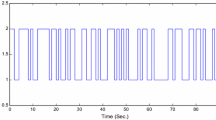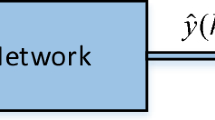Abstract
For switched cyber-physical systems with disturbances and actuator faults, we address fault detection and isolation problems. First, the preconditions relative to subsystems are discussed in detail, and the original subsystems are turned into an overall system. Second, the frequency ranges of faults are considered to belong to the finite-frequency domain, and the observer, which makes the residual robust against disturbances and sensitive to faults, is designed by combining the finite-frequency H− technique with the mixed L2 − L∞/H∞ technique. Third, design conditions, which guarantee that the error system is stable and satisfies the mixed performance, are derived using the average dwell time method and Lyapunov functionals. Finally, a traffic density dynamic model is proposed to demonstrate the validity and effectiveness of the proposed method.
Similar content being viewed by others
References
Huang R, Zhang J H, Zhang X. Adaptive tracking control of uncertain switched non-linear systems with application to aircraft wing rock. IET Control Theory Appl, 2016, 10: 1755–1762
Shen H, Xing M P, Wu Z G, et al. Multiobjective fault-tolerant control for fuzzy switched systems with persistent dwell time and its application in electric circuits. IEEE Trans Fuzzy Syst, 2020, 28: 2335–2347
Elliott R, Sun P Y, Zhu T. Electricity prices and industry switching: evidence from Chinese manufacturing firms. Energy Economics, 2019, 78: 567–588
Guo Y X, Ge S S, Fu J T, et al. Stability and stabilization of a class of switched stochastic systems with saturation control. Sci China Inf Sci, 2021, 64: 222201
Ren H L, Zong G D, Karimi H R. Asynchronous finite-time filtering of networked switched systems and its application: an event-driven method. IEEE Trans Circuits Syst I, 2019, 66: 391–402
Mu X W, Hu Z H. Stability analysis for semi-Markovian switched stochastic systems with asynchronously impulsive jumps. Sci China Inf Sci, 2021, 64: 112206
Aazan G, Girard A, Greco L, et al. Stability of shuffled switched linear systems: a joint spectral radius approach. Automatica, 2022, 143: 110434
Yang H, Zhao X D, Jiang B. Stability analysis of switched positive nonlinear systems: an invariant ray approach. Sci China Inf Sci, 2019, 62: 212206
Taousser F Z, Djouadi S M, Tomsovic K. A dwell time approach for the stabilization of mixed continuous/discrete switched systems. Automatica, 2022, 142: 110386
Zhang S Y, Nie H. Dwell-time-dependent asynchronous mixed H− and passive control for discrete-time switched systems. Nonlinear Anal-Hybrid Syst, 2022, 44: 101140
Zhuang S L, Yu X H, Qiu J B, et al. Meta-sequence-dependent H− filtering for switched linear systems under persistent dwell-time constraint. Automatica, 2021, 123: 109348
Li Y, Zhang H B. Stability, L1-gain analysis and asynchronous L1-gain control of uncertain discrete-time switched positive linear systems with dwell time. J Franklin Institute, 2019, 356: 382–406
Lu A Y, Yang G H. Stabilization of switched systems with all modes unstable via periodical switching laws. Automatica, 2020, 122: 109150
Ma R C, An S, Fu J. Dwell-time-based stabilization of switched positive systems with only unstable subsystems. Sci China Inf Sci, 2021, 64: 119205
Yang R N, Zheng W X. H∞ filtering for discrete-time 2-D switched systems: an extended average dwell time approach. Automatica, 2018, 98: 302–313
Yu Q, Lv H. Stability analysis for discrete-time switched systems with stable and unstable modes based on a weighted average dwell time approach. Nonlinear Anal-Hybrid Syst, 2020, 38: 100949
Qi W H, Park J H, Cheng J, et al. Exponential stability and L1-gain analysis for positive time-delay Markovian jump systems with switching transition rates subject to average dwell time. Inf Sci, 2018, 424: 224–234
Liu L J, Zhao X D, Sun X M, et al. Stability and l2-gain analysis of discrete-time switched systems with mode-dependent average dwell time. IEEE Trans Syst Man Cybern Syst, 2020, 50: 2305–2314
Huang D R, Hua X X, Mi B, et al. Incipient fault diagnosis on active disturbance rejection control. Sci China Inf Sci, 2022, 65: 199202
Guo S H, Zhu F L, Jiang B. Reduced-order switched UIO design for switched discrete-time descriptor systems. Nonlinear Anal-Hybrid Syst, 2018, 30: 240–255
Hua X X, Huang D R, Guo S H. Extended state observer based on ADRC of linear system with incipient fault. Int J Control Autom Syst, 2020, 18: 1425–1434
Huang J, Ma X, Che H C, et al. Further result on interval observer design for discrete-time switched systems and application to circuit systems. IEEE Trans Circuits Syst II, 2020, 67: 2542–2546
Choi H D, Ahn C K, Karimi H R, et al. Filtering of discrete-time switched neural networks ensuring exponential dissipative and l2 − l∞ performances. IEEE Trans Cybern, 2017, 47: 3195–3207
Xiong S X, Wu Q X, Wang Y H, et al. An l2 − l∞ distributed containment coordination tracking of heterogeneous multi-unmanned systems with switching directed topology. Appl Math Computation, 2021, 404: 126080
Du D X, Yang Y, Zhao H, et al. Robust fault diagnosis observer design for uncertain switched systems. Int J Control Autom Syst, 2020, 18: 3159–3166
Mei Z, Fang T, Shen H. Finite-time l2 − l∞ filtering for persistent dwelltime switched piecewise-affine systems against deception attacks. Appl Math Computation, 2022, 427: 127088
Hu X H, Xia J W, Chen X Y, et al. Non-fragile l2 − l∞ synchronization for switched inertial neural networks with random gain fluctuations: a persistent dwell-time switching law. Neurocomputing, 2020, 403: 193–202
Tai W P, Zuo D D, Xuan Z X, et al. Non-fragile l2 − l∞ filtering for a class of switched neural networks. Math Comput Simul, 2021, 185: 629–645
Hou L L, Zhao X D, Sun H B, et al. l2 − l∞ filtering of discrete-time switched systems via admissible edge-dependent switching signals. Syst Control Lett, 2018, 113: 17–26
Xiang W M, Lam J, Li P S. On stability and H∞ control of switched systems with random switching signals. Automatica, 2018, 95: 419–425
Chen Y, Zhu M Z, Lu R Q, et al. Distributed H∞ filtering of nonlinear systems with random topology by an event-triggered protocol. Sci China Inf Sci, 2021, 64: 202204
Shen Y X, Wang Z D, Shen B, et al. H− state estimation for multi-rate artificial neural networks with integral measurements: a switched system approach. Inf Sci, 2020, 539: 434–446
Zhang H, Wang Z P, Yan H C, et al. Adaptive event-triggered transmission scheme and H− filtering co-design over a filtering network with switching topology. IEEE Trans Cybern, 2019, 49: 4296–4307
Gao H, Shi K B, Zhang H B. A novel event-triggered strategy for networked switched control systems. J Franklin Institute, 2021, 358: 251–267
Liu X X, Su X J, Shi P, et al. Fault detection filtering for nonlinear switched systems via event-triggered communication approach. Automatica, 2019, 101: 365–376
Li J, Pan K P, Zhang D Z, et al. Robust fault detection and estimation observer design for switched systems. Nonlinear Anal-Hybrid Syst, 2019, 34: 30–42
Su Q Y, Fan Z X, Lu T, et al. Fault detection for switched systems with all modes unstable based on interval observer. Inf Sci, 2020, 517: 167–182
Zhai D, Lu A Y, Li J H, et al. Simultaneous fault detection and control for switched linear systems with mode-dependent average dwell-time. Appl Math Computation, 2016, 273: 767–792
Zhang Z H, Yang G H. Interval observer-based fault isolation for discrete-time fuzzy interconnected systems with unknown interconnections. IEEE Trans Cybern, 2017, 47: 2413–2424
Zhu F L, Tang Y Y, Wang Z H. Interval-observer-based fault detection and isolation design for T-S fuzzy system based on zonotope analysis. IEEE Trans Fuzzy Syst, 2022, 30: 945–955
Zammali C, Wang Z H, Gorp J V, et al. Fault detection for switched systems based on pole assignment and zonotopic residual evaluation. IFAC-PapersOnLine, 2020, 53: 4695–4700
Wang H M, Yang G H, Ye D. Fault detection and isolation for affine fuzzy systems with sensor faults. IEEE Trans Fuzzy Syst, 2016, 24: 1058–1071
Zhou M, Rodrigues M, Shen Y, et al. H−/H−, fault detection observer design for a polytopic LPV system using the relative degree. Int J Appl Math Comput Sci, 2018, 28: 83–95
Liao F, Zhu Y Z, Yang R N, et al. Integrated fault estimation and tolerant control for discrete-time switched affine systems with mixed switching laws. Nonlinear Anal-Hybrid Syst, 2022, 44: 101167
Zhang X Y. Robust integral sliding mode control for uncertain switched systems under arbitrary switching rules. Nonlinear Anal-Hybrid Syst, 2020, 37: 100900
Wang X H, Tan C P, Zhou D H. A novel sliding mode observer for state and fault estimation in systems not satisfying matching and minimum phase conditions. Automatica, 2017, 79: 290–295
Zhu F L. State estimation and unknown input reconstruction via both reduced-order and high-order sliding mode observers. J Process Control, 2012, 22: 296–302
Zhang J C, Zhao X D, Zhu F L, et al. Reduced-order observer design for switched descriptor systems with unknown inputs. IEEE Trans Automat Contr, 2020, 65: 287–294
Zhang X M, Zhu F L. Observer-based sensor attack diagnosis for cyber-physical systems via zonotope theory. Asian J Control, 2021, 23: 2444–2458
Liang D G, Yang Y, Li R C, et al. Finite-frequency H−/H∞ unknown input observer-based distributed fault detection for multi-agent systems. J Franklin Institute, 2021, 358: 3258–3275
Wang H, Yang G H. A finite frequency domain approach to fault detection observer design for linear continuous-time systems. Asian J Control, 2008, 10: 559–568
Guo Y Q. Dynamic-model-based switched proportional-integral state observer design and traffic density estimation for urban freeway. Eur J Control, 2018, 44: 103–113
Zeroual A, Harrou F, Sun Y. Road traffic density estimation and congestion detection with a hybrid observer-based strategy. Sustain Cities Soc, 2019, 46: 101411
Acknowledgements
This work was supported in part by National Natural Science Foundation of China (Grant Nos. 62273065, 61703296), China Postdoctoral Science Foundation (Grant No. 2022M721901), and Opening Project of the Key Laboratory of Bionic Engineering (Ministry of Education), Jilin University (Grant No. K202208).
Author information
Authors and Affiliations
Corresponding author
Rights and permissions
About this article
Cite this article
Guo, S., Tang, M., Huang, D. et al. State estimation and finite-frequency fault detection for interconnected switched cyber-physical systems. Sci. China Inf. Sci. 66, 192204 (2023). https://doi.org/10.1007/s11432-022-3705-2
Received:
Revised:
Accepted:
Published:
DOI: https://doi.org/10.1007/s11432-022-3705-2




